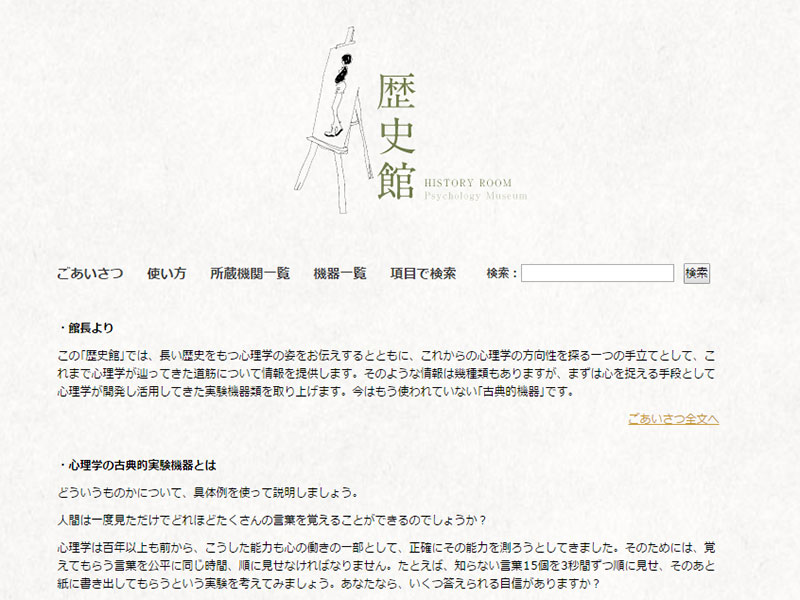Frequently Asked Questions about
the Online Psychology Museum
- Question: Who is the host of this website?
- Answer: This website is operated by the Museum Committee of the Japanese Psychological Association (JPA).
- Question: What is the JPA?
- Answer: The JPA was founded in 1927, and is the oldest psychological association in Japan among 53 academic societies that belong to the Japanese Union of Psychological Associations. The JPA has approximately 8,000 members as of November 2018. Members mainly include researchers in public and private educational institutes. Please visit the JPA website for more information, and check the references below for the history of psychology in Japan.
- Question: When did you start the Online Psychology Museum?
- Answer: The JPA organized the Museum Committee in 2010, and the committee members launched this website in 2011.
- Question: What do you offer on the Online Psychology Museum?
- Answer: So far, we have built three main virtual “halls”:
- Exhibit Hall introduces the famous, influential, exciting, or socially important findings of psychology. Each finding is described in 15 to 20 slides, with graphic illustrations. We are encouraging and inviting members of the JPA to contribute to the exhibition.

- • History Hall consists of two rooms. In the Oral History Room, we offer the interview records of Japanese psychologists who contributed to the development of psychology after World War II. In the Classical Experimental Apparatus Room, we collect the high-resolution digital images of the classical experimental apparatuses owned by Tohoku University, Kyoto University, Ritsumeikan University, Kwansei Gakuin University, and The University of Tokyo. Thus far, we have nearly 300 psychological instruments in the areas of perceptual, physiological, learning, clinical, and vocational psychology, among others.

- • Link Mall lists the Japanese and foreign websites that efficiently illustrate psychological methods and phenomena (e.g., statistics, experimental tools, visual and auditory illusions).
Note. The content described above is only available in Japanese at this moment. Please check again in the near future as we provide some of this content in English.
- Exhibit Hall introduces the famous, influential, exciting, or socially important findings of psychology. Each finding is described in 15 to 20 slides, with graphic illustrations. We are encouraging and inviting members of the JPA to contribute to the exhibition.
- Question: Are there any “actual” museum activities?
- Answer: We also conduct real-world exhibiting activities in existing science museums. The photos show the onsite illustrations of the rubber hand illusion and the mere exposure effect at the 2015 Science Festival of the Shizuoka Science Museum, Rukuru.

- Question: What is your mission?
- Answer: Our mission is to disseminate knowledge about psychology to the public, especially since the JPA was approved as a Public Interest Incorporated Association in 2011. Through these online and onsite activities, we aim to arouse and maintain the interest of a wide range of people, to promote psychological research, and to contribute to the well-being of people and society.
- Question: Who is the character?
- Answer:
Hi, I am a witch, Saiko. They call me “Saiko-chan” in Japan. I don’t know my age, but perhaps 13 or so in human years. I am learning psychology to become a full-fledged witch, because we want to know more about the human mind so that we become friends and live happily with the human race.

- References
- Azuma, H., & Imada, H. (1994). Origins and development of psychology in Japan: The interaction between Western science and the Japanese cultural heritage. International Journal of Psychology, 29(6), 707-715.
Imada, H., & Tanaka‐Matsumi, J. (2016). Psychology in Japan. International Journal of Psychology, 51(3), 220-231.
Japanese Psychological Association. (2012). About JPA. Retrieved from http://www.psych.or.jp/english/about_us.html
Misumi, J., & Peterson, M. F. (1990). Psychology in Japan. Annual Review of Psychology, 41(1), 213-241.
Nishikawa, Y. (2005). An overview of the history of psychology in Japan and the background to the development of the Japanese Psychological Association. Japanese Psychological Research, 47, 63-72.
Oyama, T., Sato, T., & Suzuki, Y. (2001). Shaping of scientific psychology in Japan. International Journal of Psychology, 36(6), 396-406.
Sato, K., & Graham, C. H. (1954). Psychology in Japan. Psychological Bulletin, 51(5), 443-464.
Sato, T., & Omi, Y. (Eds.). (2016). Commemoration of ICP2016: History of Psychology in Japan and Within the Context of East Asia. Japanese Psychological Research, 58(S1).
Tanaka, Y., & England, G. W. (1972). Psychology in Japan. Annual Review of Psychology, 23(1), 695-732.

Museum Committee
Japanese Psychological Association
Email: jpa@psych.or.jp
Address:
Japanese Psychological Association
5-23-13 Hongo, Bunkyo-ku
Tokyo, 113-0033 Japan
Last Updated: November 5, 2018

